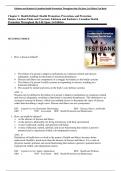Exam (elaborations)
Edelman and Kudzma's Canadian Health Promotion Throughout the Life Span, 1st Edition Test Bank by Shannon Dames
The document is not the original book; it's a handy collection of pre-written exam questions and answers that helps educators gauge students' understanding of the course material. It’s a great resource for creating quizzes and exams, saving teachers time and ensuring students are assessed f...
[Show more]



